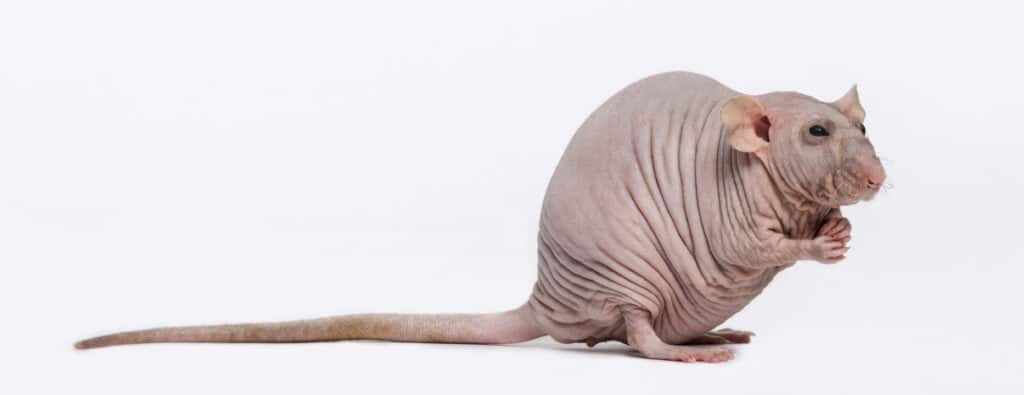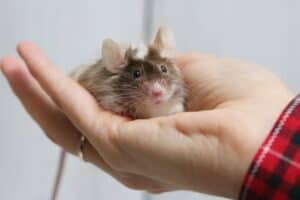Rodent lovers love having rats as pets, but many do not know that they could have a hairless rat as a pet. Hairless rats are similar to normal, furry rats but need additional care and love to live a happy, healthy life. If you are interested in owning hairless rats, what you need to know about them is in this article.

Hairless rats are born with fur but lose it shortly after birth due to their defective immune systems.
©Eric Isselee/Shutterstock.com
How To Recognize a Hairless Rat
As the name suggests, a hairless rat does not have fur or hair. The hairless rat is a variation of the fancy rat and is recognizable by its pink, smooth, hairless skin. Besides this, the rats share the same characteristics as normal rats and have black or red eyes.
The hairless rat has become hairless due to a genetic mutation. This mutation results in the rat’s thymus gland not fully forming. Interestingly, the hairless rat is born with hair but loses it due to a unique quirk in their immune system. Because of their faulty immune systems, these rats develop health issues and do not have a long lifespan, only living for roughly one year.
Types of Hairless Rats
There are three different types of hairless rat subspecies with diverse genetic makeups. The different types of hairless rats are:
Double Rex Hairless Rats. These hairless rats have two rex genes which results in them being hairless. Uniquely, the double rex hairless rat has eyebrows and curly whiskers. These rats, which can be a range of different colors, also may have small patches of hair on their head and feet.
Patchwork Hairless Rats. These subspecies also have two rex genes. As their name suggests, this rat grows small patches of hair across its body, resembling patchwork. As these rats age, they lose their patchwork hairy spots, with new hair growing in their place. Like the double rex hairless rats, these rodents feature various coat colors.
Sphynx or Truly Hairless Rats. This hairless rat is less common and takes its name from the hairless cat breed, the Sphynx. Breeders purposefully breed the sphynx rats without any fur at all and are often used in labs for research. These rats have a short lifespan, living half the usual period of many others. Unfortunately, they also have health issues and suffer from respiratory, bacterial, kidney, and liver diseases due to congenital deficiencies in their immune system.
Diet
The diet of the hairless rat is not much different from that of other rats. The main difference is that hairless rats need large amounts of food and water. Hairless rats need more food and water than other rats because they have a higher metabolism and need more calories to keep warm as they do not have fur.
Pet hairless rats should be fed rat pellets and fruits and vegetables. The recommended diet is a ratio of 80% rat pellets and 20% fruits and vegetables.
Hairless rats enjoy fruits and vegetables like:
- Bananas
- Broccoli
- Carrots
- Grapes
- Kale
- Kiwi
- Pears
- Plums
- Spinach
- Sweet Potatoes
- Watermelon

The diet of a pet hairless rat should include pellets, fruits, and vegetables.
©Eric Isselee/Shutterstock.com
Pet owners should always chop fresh fruit and vegetables into small pieces. Another vital tip to owning these animals as pets is to never leave excess fruit and vegetables in their enclosures for more than a day for hygiene and health reasons. It is also advisable to add supplements to the hairless rat diet to ensure their skin stays hydrated. An example of a suitable supplement is olive oil.
Cages and Bedding
Hairless rats need a cage one foot tall and two feet wide, at minimum. A wire cage works well for a hairless rat, but only if you can keep the room warm. Ensure that the cage has no sharp objects as these can pierce their skin and injure them. Additionally, experts advise that you keep the enclosure warm. The typical cage temperature for other rats is between 64 and 79 degrees Fahrenheit, so it should be slightly warmer for your hairless rat.
Usually, rats enjoy bedding made out of paper strips, but you should avoid this medium for hairless rats. Strips of paper may irritate their skin and even lead to paper cuts. Soft, absorbent bedding is ideal for these rodents. You should also change their bedding regularly as it becomes soiled with their urine and feces, which may irritate and scald their skin. If your hairless rat has toys and hammocks in their enclosure, you must also clean these items regularly.
Health Issues
The hairless rat has a faulty immune system, resulting in sensitivity to bacteria and health issues. These rodents are often also born with health issues and suffer from respiratory, bacterial, kidney, and liver diseases. And although hairless rats are bald, they still have hair follicles. Their hair follicles have the potential to become clogged, causing possible pimples and infections. If a follicle does become infected, it can be fatal for the hairless rat.
Since the hairless rat has no hair, it does not have the protection this element would provide. Consequently, these pets can easily scratch and cut their skin. This risk is why it is essential to buy enclosures that do not have sharp objects. This requirement also applies to their bedding and toys, which must not have sharp, abrasive characteristics.

Avoid sharp edges and objects in your pet hairless rat’s cage as these can hurt their delicate skin.
©Pighurska Valentyna/Shutterstock.com
Lifespan
Hairless rats – what you need to know is that they do not have the average lifespan of other rats. Most live for two or three years, but hairless rats rarely make it to a year. This short lifespan is because hairless rats cannot successfully fight off infections.
The photo featured at the top of this post is © iStock.com/Elena Neveditsyna
Thank you for reading! Have some feedback for us? Contact the AZ Animals editorial team.






